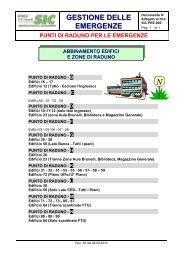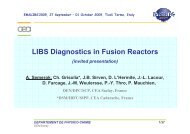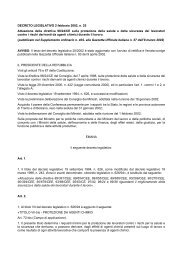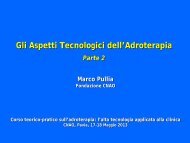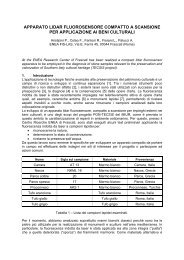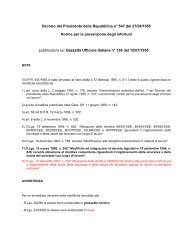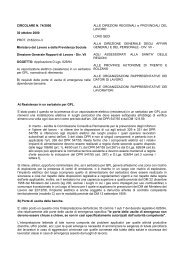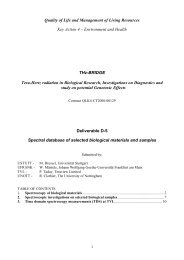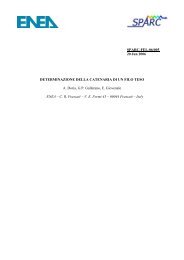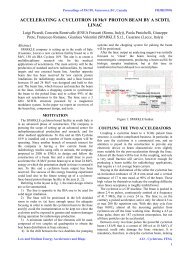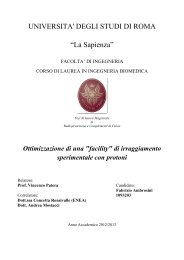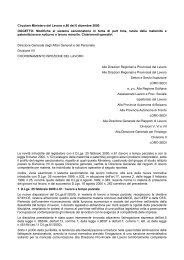Theory, Design and Tests on a Prototype Module of a Compact ...
Theory, Design and Tests on a Prototype Module of a Compact ...
Theory, Design and Tests on a Prototype Module of a Compact ...
Create successful ePaper yourself
Turn your PDF publications into a flip-book with our unique Google optimized e-Paper software.
4. THE PERTURBED AXIAL FIELD 59<br />
where we introduced the new error parameter<br />
N<br />
<br />
L εp + εR p<br />
ε ∗ p =<br />
p=1<br />
2<br />
+ (−1) p εR p − ε L p<br />
2<br />
<br />
(4.53)<br />
In order to evaluate the frequency error <str<strong>on</strong>g>and</str<strong>on</strong>g> remembering the equati<strong>on</strong><br />
(4.11), <strong>on</strong>e obtains<br />
<br />
<br />
1<br />
∆ω = ω0 √ − 1 ∼ K<br />
= −jω0 sinh ∆x (4.54)<br />
1 − jK sinh ∆x 2<br />
Since ∆x is <strong>of</strong> the same order <strong>of</strong> magnitude <strong>of</strong> all the ε L,R<br />
p , it is accept-<br />
able the following approximati<strong>on</strong><br />
K<br />
∆ω = −jω0<br />
2 sinh<br />
<br />
j 1<br />
N<br />
N<br />
p=1<br />
ε ∗ p<br />
<br />
∼ = ω0K<br />
2N<br />
N<br />
p=1<br />
ε ∗ p<br />
(4.55)<br />
Note that the quantity ε ∗ p is equal to ε R p for even p, <str<strong>on</strong>g>and</str<strong>on</strong>g> for odd p it is<br />
equal to ε L p . Then, ∆ω is proporti<strong>on</strong>al to the following sum<br />
ε L 1 + ε R 2 + ε L 3 + ε R 4 + ε L 5 + . . . (4.56)<br />
which is a sum over the odd cavities.<br />
This is a general result since it states that the frequency error <strong>of</strong><br />
the whole chain depends <strong>on</strong>ly <strong>on</strong> the errors in the accelerating cavities,<br />
which are the charged <strong>on</strong>es for the mode π/2 mode. It is worth noting<br />
that this result is obtained under the hypothesis <strong>of</strong> negligible n<strong>on</strong>adjacent<br />
cavities coupling, since in the other case the stop-b<str<strong>on</strong>g>and</str<strong>on</strong>g> c<strong>on</strong>cept<br />
is involved <str<strong>on</strong>g>and</str<strong>on</strong>g> the errors in the coupling cavities become important.<br />
Furthermore, the expressi<strong>on</strong> (4.55) does not c<strong>on</strong>tain product <strong>of</strong> different<br />
cavity errors, as we arrested the expansi<strong>on</strong> to the first order, namely we<br />
neglect the correlati<strong>on</strong> am<strong>on</strong>g the errors. Finally, under the previous<br />
hypothesis, it is also clear that the frequency error is independent <strong>of</strong> the<br />
relative positi<strong>on</strong>s <strong>of</strong> the cavities <str<strong>on</strong>g>and</str<strong>on</strong>g> that the variance <strong>of</strong> the frequency<br />
error is N times the <strong>on</strong>e <strong>of</strong> the variables ε L,R<br />
p .<br />
4. The perturbed axial field<br />
In the circuit model, the voltage <strong>on</strong> the capacitance <strong>of</strong> a generic<br />
cell is equal to the accelerating voltage. Then, except for the term<br />
1/(jω2Ci) (1/(jωCi) for the lateral half cells), we look for the current<br />
Ii which is<br />
<br />
N<br />
Ii =<br />
<br />
, for i = 1, 2, . . . , N (4.57)<br />
l=i<br />
Tl<br />
22<br />
Note that such an expressi<strong>on</strong> comes from the hypothesis IN+1 = 1<br />
which means that the last half cell is short-circuited <str<strong>on</strong>g>and</str<strong>on</strong>g> we arbitrarily<br />
fixed the current to <strong>on</strong>e. In the following, we always use this hypothesis,<br />
<str<strong>on</strong>g>and</str<strong>on</strong>g> i = 1, 2, . . . , N.



